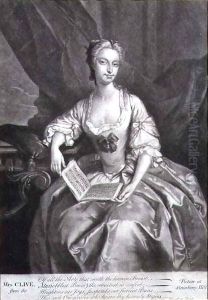Jozef van Aken Paintings
Jozef van Aken was a Flemish artist, known for his skill in painting fabrics and costumes, who made a significant impact in the British art scene of the 18th century. Born around 1699 in Antwerp, Belgium, into a family with a strong artistic heritage, van Aken's early life was steeped in the rich traditions of Flemish painting. His brother, Alexander van Aken, was also a painter, indicating that artistry ran in the family. Despite the prominence of his work in Britain, little is known about van Aken's early years and training in Antwerp, a city famed for its vibrant artistic community and as a center of the Baroque movement.
Jozef van Aken moved to London in the 1720s, where he quickly established himself as a sought-after artist, particularly known for his ability to paint clothing and drapery with exquisite detail and realism. This talent made him an invaluable asset to many of the leading portrait painters of the time in England. He often collaborated with these artists, painting the clothing and drapery in portraits whose faces and hands were executed by others. This practice was not uncommon in the 18th century, allowing artists to capitalize on their specific strengths and contributing to the collaborative nature of the art community during this period.
Although van Aken himself painted entire compositions, he is most remembered today for his contributions to the works of others. His ability to render fabric with such authenticity and refinement brought a level of detail and luxury to the portraits that was highly prized by the Georgian nobility and gentry, who were the primary patrons of the arts at the time. His work can be seen as embodying the opulence and elegance of the period, making significant contributions to the visual documentation of 18th-century fashion and interior design.
Unfortunately, despite his contributions to the art world and the high demand for his skills, Jozef van Aken did not achieve the same level of fame as some of his contemporaries. He passed away in London in 1749, and over time, his name became somewhat obscured in the annals of art history. Nonetheless, his work continues to be studied and appreciated for its technical skill, particularly in the depiction of textiles, contributing valuable insights into the collaborative nature of portrait painting in 18th-century England and the broader European artistic context of the time.
